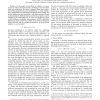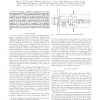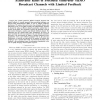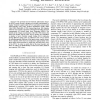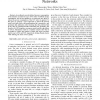ICC
2009
IEEE
15 years 7 months ago
2009
IEEE
— In this paper, we introduce an adaptive Lp–norm metric for robust coherent diversity combining in non–Gaussian noise and interference. We derive a general closed–form exp...
ICC
2009
IEEE
15 years 7 months ago
2009
IEEE
—This paper presents a cooperative single-input multiple-output (SIMO) transmission scheme for wireless sensor networks (WSNs), where the number of antennas and the constellation...
106
click to vote
ICC
2009
IEEE
15 years 7 months ago
2009
IEEE
—We study the energy performance of random linear network coding for time division duplexing channels. We assume a packet erasure channel with nodes that cannot transmit and rece...
ICC
2009
IEEE
15 years 7 months ago
2009
IEEE
— In this paper, we introduce a novel Markov Chain (MC) representation aided Minimum Bit Error Rate (MBER) detection method that is applicable to an M-QAM modulated SDM/SDMA upli...
118
click to vote
ICC
2009
IEEE
15 years 7 months ago
2009
IEEE
—Wireless ad hoc networks are connected to the fixed Internet by means of Internet gateways. Whenever a node within the ad hoc network wishes to communicate with a host in the I...
150
click to vote
ICC
2009
IEEE
15 years 7 months ago
2009
IEEE
—We consider multi-user MIMO broadcast channels with limited feedback. A recently proposed linear precoding technique, regularized block diagonalization (RBD), is used to mitigat...
ICC
2009
IEEE
15 years 7 months ago
2009
IEEE
—We study a sensor node with an energy harvesting source. In any slot, the sensor node is in one of two modes: Wake or Sleep. The generated energy is stored in a buffer. The sens...
ICC
2009
IEEE
15 years 7 months ago
2009
IEEE
—A network with two sources, one relay, and one destination is considered. Under the assumption of noisy sourcerelay links causing the relay to be unable to decode without error,...
ICC
2009
IEEE
15 years 7 months ago
2009
IEEE
—According to several studies, the power consumption of the Internet accounts for up to 10% of the worldwide energy consumption, and several initiatives are being put into place ...
